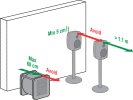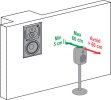sweetsounds
Active Member
- Joined
- Apr 24, 2019
- Messages
- 155
- Likes
- 313
There are multiple threads on ASR about reflections, including:
Perceptual Effects of Room Reflections - @amirm
Research on Reflections - @aarons915
However, it is mostly lateral reflections which are being discussed. There seems to be good science on lateral reflections, so we will NOT be discussing that here. Instead, what I would like to discuss are frontal reflections.
For a long time, I believed that frontal reflections are just like lateral reflections, in that within a certain window of time and amplitude, they create spaciousness. I simply transposed my understanding of lateral reflections to frontal reflections and used the same target - ETC should show a peak which is >-15dB with respect to the main impulse within the Haas fusion window of 20ms.
Without confusing you more, I am afraid, that the effect of front- and back-wall reflections is not a simple answer.
All data in the articles and experience point to contradicting data: bipolars and omnipolars can have great spatiality, as can have monopoles in absorptive environments. The reverse can also be true.
In my experience is
Different from good speaker sound, which is "just" a flat frequency response, spatiality involves time signature, time phase, directivity and time difference between the ears. Even if the freq response is flat, it says little about perceived spatiality.
My explanation is the following:
- depth and width are psycho-acoustic interpretations of the brain to conclude from echos and timing differences, where the source of a sound is.
For human survival, the location of a sound was a life-or-death information.
- the key is the sound reaching your ears with the Haas window of ~40ms.
- during recording and mastering delayed sounds in the mix create the "natural depth". However, as
- are the reflections coherent to the source? i.e. does the reflection come from the same direction within a small delay from the initial sound? This is bipolar/omnipolar, which adds early reflections/echos which the brain interprets as depths. Here the room+speaker add "replay depths", which is not on the recording, but the ears interpret it the same as depth.
- if the reflections have a very different time and spatial signature (e.g. 2nd order reflections from the front- or 1st order from the back walls), the perceived depth decreases. The brain seems to interpret the sound field then as a diffuse field, meaning it can't conclude on the location of the sound.
- purely late, diffuse reflections coming from all directions (incoherent) are not detrimental. The brain has already concluded, where the sound must be coming from.
All of that might not help you, except that adding more coherent and consistent sound reflections in the Haas window (or eliminating incoherent sounds) will improve spatiality.


